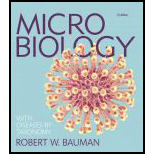
Concept explainers
Clinical Case Study Legionella in the Produce Aisle

Legionnaires’ disease, or legionellosis, is a potentially fatal respiratory disease caused by the growth of a bacterium, Legionella pneumophila, in the lungs of patients. The bacterium enters humans via the respiratory portal in aerosols produced by cooling towers, air conditioners, whirlpool baths, showers, humidifiers, and respiratory therapy equipment. Several years ago, the Louisiana state health department received reports of 33 cases of Legionnaires’ disease in the town of Bogalusa. LA (population 16,000).
Epidemiologists tried to ascertain the source of Bogalusa’s outbreak of Legionnaires’ disease by interviewing the victims and their relatives to develop complete histories and to identify areas of commonality among the victims that nonvictims did not share. Victims included a range of ages, occupations, hobbies, religions, and types and locations of dwellings. Although no significant differences were identified among the lifestyles, ages, or smoking habits of victims and nonvictims, one curious fact was discovered: all the victims did their grocery shopping at the same store. However, healthy individuals also shopped at that store.
The air-conditioning system of the grocery store proved to be free of Legionella, but the vegetable misting machine did not. The strain of Legionella isolated from the misting machine was identical to the strain recovered from the victims’ lungs.
- 1. Would this outbreak be classified as endemic, epidemic, or pandemic?
- 2. Is this a descriptive, analytical, or experimental epidemiological study?
- 3. Knowing the epidemiology and causative agent of Legionnaires’ disease, what questions would you ask of the victims or of their surviving relatives?
- 4. What, as an epidemiologist, would you examine at the store?
- 5. How did the victims become contaminated? Why didn’t everyone who bought vegetables at the store get legionellosis? What could the owners of the store do to limit or prevent future infections?
Want to see the full answer?
Check out a sample textbook solution
Chapter 14 Solutions
Microbiology: ... by Taxonomy (Instructor's)
- Psitticosis is a _________infection associated with ___________- .a. rickettsial, parrots b. chlamydial, mice c. chlamydial, birds d. rickettsial, fliesarrow_forward"Presence of lactobacillus species, alpha-streptococci, dna diphtheroids in cultured urine specimen suggests" contaminated sample possible infection significant bacteriuria bladder infectionarrow_forwardSingle Matching. Match the disease with its common name.____________coccidioidomycosis a. tinea____________histoplasmosis b. San Joaquin Valley fever____________blastomycosis c. South American blastomycosis____________sporotrichosis d. Chicago disease____________paracoccidioidomycosis e. rose-gardener’s disease____________dermatophytosis f. yeast infection____________candidiasis g. Ohio Valley feverarrow_forward
- Mycobacterium tuberculosis infects the upper regions of the lungs. This bacteria is classified as a(n)___. aerobe thermophile saprophyte anaerobearrow_forwardGiardia intestinalis (old species designation was lamblia)- flagellated protozoa in a fecal smear. Must look for the trophozoites (metabolizing stage that look a bit like little faces- label them as such as well as flagella. They have 2 nuclei which are what appear as "eyes"). (1000x). Include some background material in drawing since it is not a pure culturearrow_forwardClinical Case Study Four generations of the DOE family live in the southeastern United States: 72 -year old grandmother Nancy, 44-year old father Chad, Chad's oldest daughter, Gina, 23 years old, and Gina's 18 month-old son Joseph. As a whole, the family has had no previous significant medical history, yet interfaces with their primary care physician and medical specialists throughout their lifespan for various conditions. While laboratory analysis often involved the collection of routine blood and urine specimens, the cases in this chapter will highlight times when they needed other body fluids collected for diagnostic purposes. 1) Besides blood and urine, what are other body fluids that can be collected for diagnostic purposes? 2) Do you believe that there are body fluids that are only clinically relevant at certain time points in life? Or, instead, are the diagnostic utility of these fluids equal across the lifespan?arrow_forward
- write out a detailed summary on Salmonella. Questions below will help you frame your summary. Please describe the bacterium. What is its shape and size? Is it Gram-positive or negative? Pictures are always fun! If you can find a microscopic image – include it. What is/are the reservoir(s)? e.g. water, food, human, etc. Are there parameters needed for infection? (Temperature, pH) What is/are the mode(s) of transmission. If it's foodborne - is it linked to a specific food? How many cases occur each year? In the US and/or worldwide and/or in the County where you live Has it caused any outbreaks or epidemics? Thank you-arrow_forwardPathology caused by p.falciparum is worst of all the known plasmodium species. Commentate.arrow_forwardType of infection for the following and small info about them: A. Naegleria fowleri B. Acanthamoeba species C. Entamoeba histolytica D. Giardiasis E. Balantidiasis F. Sleeping sickness. G. Toxoplasmosis.arrow_forward
- NON PATHOGENIC AMEBA Why do we call Entamoeba hartmanii as the small race Entamoeba histolytica? Is it necessary to treat patients with commensal protozoans? Should we report the presence of the non-pathogenic amoeba in the official fecalysis report?arrow_forwardTrichomonas vaginalis may exhibit multiple flagella. True Falsearrow_forwardDetection for chlamydia This paragraph explains: Where in the body is the pathogen usually detected? (throat, blood, tissue, etc.) What is the usual clinical method for detection? (biopsy microscopy, ELISA, PCR, etc.)arrow_forward
 Biology: The Unity and Diversity of Life (MindTap...BiologyISBN:9781305073951Author:Cecie Starr, Ralph Taggart, Christine Evers, Lisa StarrPublisher:Cengage Learning
Biology: The Unity and Diversity of Life (MindTap...BiologyISBN:9781305073951Author:Cecie Starr, Ralph Taggart, Christine Evers, Lisa StarrPublisher:Cengage Learning
